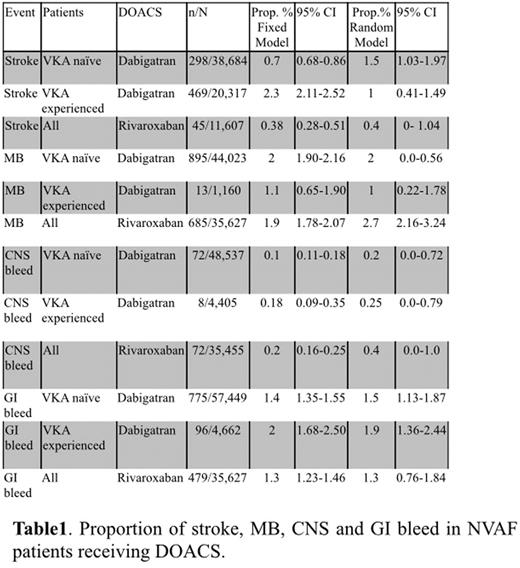Abstract
Background.Safety and efficacy of direct oral anticoagulants (DOACS) has been established in randomized trials but an increasing number of "real world" data outside clinical trials has become available after approval. In this study we aimed to assess the efficacy and safety of DOACS in population-based studies in the context of non-valvular atrial fibrillation (NVAF), thromboprophylaxis in orthopedic surgery (OS), and treatment of acute venous thromboembolism (VTE).
Methods.We conducted a systematic review of observational studies assessing the safety and efficacy of DOACs (including dabigatran, rivaroxaban and apixaban) in patients with NVAF, OS and VTE treatment. Efficacy outcomes included stroke (NVAF studies) and VTE (OS studies). Safety outcomes included major bleeding (MB) (as defined by investigators), gastrointestinal (GI) and central nervous system (CNS) bleeding. If feasible we conducted a meta-analysis of incidence rates (IR) and proportions using both fixed and random effects models.
Results.Of 84 potentially relevant studies we included36 full text articles published between 2012 and 2016. Three groups of studies were identified: NVAF (22 studies), thromboprophylaxis in OS (10 studies), and miscellaneous (4 studies).Of the miscellaneous studies, only 1 study assessed DOACS in the treatment of acute VTE.
Studies assessing NVAF. The 22 studies included 158,554 patients of which, 70,608 were evaluable for stroke, 80,810 for MB, 88,397 for CNS bleed, and 97,738 for GI bleed. Overall, the percent of patients developing stroke, MB, CNS and GI bleed were similar with both random and fixed models (Table 1). Among NVAF patients, a meta-analysis of studies with follow up information (7 studies, n=40,955) showed that the IR of stroke for all DOACS was 1.8 [95%CI: 1.72-1.98] and 2.3 [95%CI: 1.99-2.61] per 100 person - year (100 PY) for the fixed and random estimates, respectively, regardless of previous vitamin K antagonist (VKA) exposure. The IR of CNS bleeding with dabigatran was 0.6 [95%CI: 0.54-0.72] and 1.3 [95%CI: 0.13-2.47] per 100 PY for fixed and random estimates, respectively. The IR of bleeding-related deaths in NVAF with all DOACS was 0.1 [95%CI: 0.07-0.17] per 100 PY (fixed) and 0.2 [95%CI: 0-0.8] per 100 PY (random).
Sensitivity analyses showed that in VKA naïve patients, dabigatran at 110 mg bid (D110) carried a significantly higher risk of stroke than dabigatran 150 mg bid (D150) [RR: 3.4; 95%CI: 2.57-4.50; p<0.0001], whereas in VKA experienced patients the risk of stroke with D110 was similar to D150 [RR: 2.0; 95%CI: 0.76-5.28; p=0.15]. In dabigatran users, VKA naïve patients carried around a 2-fold significant increase in the risk of major bleeding (MB) compared to previous VKA users [RR: 1.8; 95%CI: 1.05-3.12; p=0.03]. While the proportion of CNS bleeding was extremely low with all doses of all DOACS, the risk of GI bleed with D150 was statistically significantly higher than that of D110 in both populations of VKA naïve [RR:1.6; 95%CI: 1.14-2.31; P=0.006], and VKA experienced dabigatran users [RR: 8.3; 95% CI: 3.39-20.46; p<0.0001].
Studies in OS. Studies assessing DOACs in patients undergoing orthopedic surgery (n=27,158) showed a VTE rate of 0.8% [95%CI: 0.73-0.95] (fixed) and 1.5% [95%CI: 1.8-1.11] with (random). The MB rate was 0.7% [95%CI: 0.61-0.81] (fixed) and 2.2% [95%CI: 2.61-1.79] (random).
Conclusion.DOACS used in NVAF and orthopedic surgery are effective and safe in real-world studies as in RCTs. However, in NVAF, dabigatran dose and previous exposure to VKA seem to impact the risks of stroke, MB, and GI bleed. CNS bleed rates were consistently low with all DOACS at all doses, whether in VKA naïve or VKA experienced populations. Data for apixaban and VTE treatment is currently limited.
Lazo-Langner:Pfizer: Honoraria; Daiichi Sankyo: Research Funding; Bayer: Honoraria.
Author notes
Asterisk with author names denotes non-ASH members.


This feature is available to Subscribers Only
Sign In or Create an Account Close Modal